Survey
Sleep Slowdown
Sleep revenue growth stagnates, might slow in the next 12 months.
- By Joseph Duffy
- Jun 01, 2013
 Sleep growth appears to be slowing, according to the second quarter 2013 survey of sleep providers, conducted by HME Business magazine and Mizuho Securities USA. Respondents to the twice-yearly survey indicated that HME sleep revenue growth could slow over then next 12 months.
Sleep growth appears to be slowing, according to the second quarter 2013 survey of sleep providers, conducted by HME Business magazine and Mizuho Securities USA. Respondents to the twice-yearly survey indicated that HME sleep revenue growth could slow over then next 12 months.
Moreover, the study also indicated that Round Two contract winners plan to negotiate lower prices; Medicare re-supply policy changes have created a small drag on mask sales; and price declines are expected for flow generators and masks.
Slower Sleep Revenue Growth
According to the survey, HME providers reported an average 5.5 percent growth in their sleep revenue over the last 12 months. This growth is the same as reported in a HME Business Magazine and Mizuho Securities USA survey administered in the fourth quarter of 2012.
On average, respondents of the latest survey say that they expect their sleep revenue to grow by 2.5 percent in the next 12 months, which is down from 3.8 percent, which was reported in the fourth quarter 2012 survey. Some more key findings:
- Of the respondents of the latest survey, 17 percent say they suffered a decline in their sleep revenue in the last 12 months, while 26 percent expect a decline in the next 12 months. HME Business Magazine and Mizuho Securities USA suspect that the growth outlook has worsened from the last survey because of the impact of competitive bidding.
- About 37 percent of respondents reported sleep revenue growth in the last 12 months between 0 and 9 percent, while about 2 percent reported a decline in growth by 20 percent to 29 percent.
- About 29 percent reported sleep revenue will grow in the next 12 months between 0 and 9 percent, and about 2 percent report an expected decline in growth by 20 percent and 29 percent.
- About 2 percent predict growth by 30 percent or more in the next 12 months.
Also, respondents view the economy as a hindrance to sleep revenue growth. On average, survey takers expect the sluggish economy to reduce their sleep revenue by 1.6 percent over the next 12 months compared with a 1.5 percent reduction reported in the fourth quarter 2012 survey.
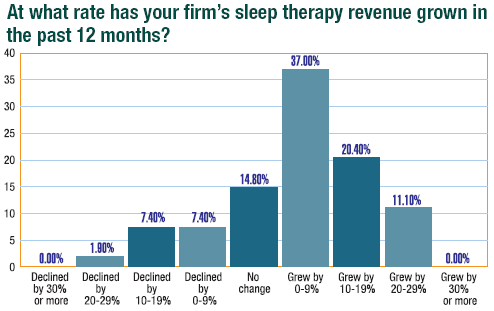
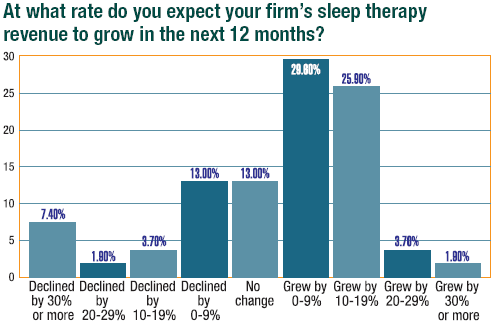
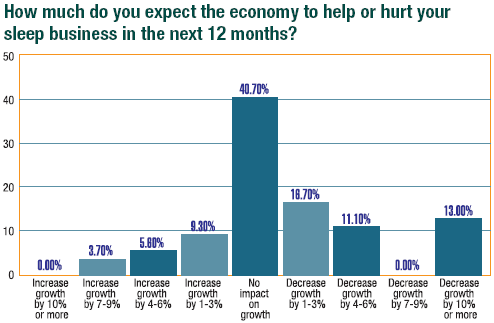
Re-supply Business
A sleep re-supply business can help patients with compliance and effective therapy while helping create new revenue streams. Respondents were asked, “Does your firm actively follow up with sleep patients to maximize re-supply sales?”
A large majority of respondents (92 percent) said that they follow-up with their sleep patients to drive re-supply sales. Methods used, starting with the most popular, include live telephone calls (used by 68 percent of respondents), automated telephone calls (38 percent), mail (34 percent) and email (34 percent).
Respondents also pointed out that Medicare’s new re-supply policy change would be another hindrance to sleep revenue growth. When asked how much has Medicare’s new re-supply policy affected your firm’s re-supply sales to Medicare patients, about 46 percent said no change, 25 percent said sales were decreased by 10 percent to 19 percent, and about 3 percent said their sales decreased by 30 percent to 39 percent.
On average, respondents have seen a 5.6 percent reduction to Medicare sleep re-supply sales versus the 7.4 percent reduction reported in the fourth quarter 2012 survey. HME Business Magazine and Mizuho Securities USA says that this translates into a 1.4 percent reduction in U.S. mask and accessory market growth. However, 77 percent of respondents expect other insurers to copy Medicare’s new re-supply policies, so the overall impact could increase.
When asked how many CPAP masks do your sleep patients use per year, respondents reported that patients used an average of 2.15 masks per year in the last 12 months and they expect this to decrease to 1.96 masks per year in the next 12 months. While this seems like a small change, HME Business Magazine and Mizuho Securities USA estimate that it could reduce mask market growth by approximately 9 percent.
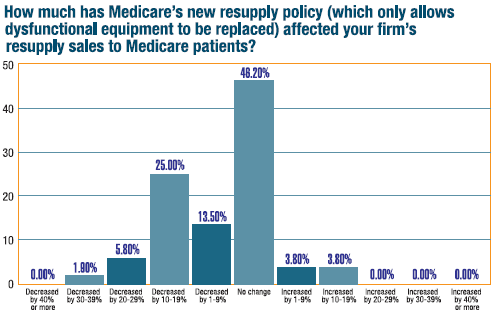
Respondents said that their firms’’ payer mix for CPAP products included:
- Private insurance (50 percent of respondents)
- Medicare (34 percent)
- Medicaid (10 percent)
- Retail (i.e., self-pay or out of pocket) (6 percent)

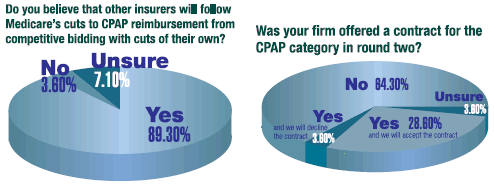
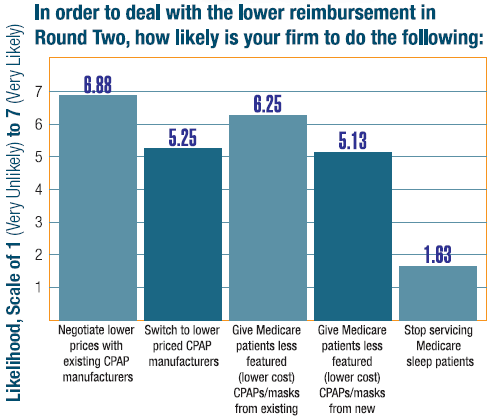
Competitive Bidding
A little more than half (53 percent) of respondents said that their firms operate in a round 2 bidding area. When asked if they expected other insurers to cut reimbursement based on the Medicare bid levels, 84 percent said yes, while 16 percent said no. Of those respondents in the round 2 bidding areas, 85 percent bid on the CPAP category with 28 percent reporting being offered and planning to accept contacts. Of those winning contracts, 4 percent plan to decline the contract.
“In order to cope with the reduced reimbursement under competitive bidding, respondents who plan to accept round two contracts are most likely to seek better pricing from their current CPAP suppliers and to shift patients to lower-end products from their current CPAP suppliers. And nearly all of these respondents (87 percent) indicated that they have already begun to implement these strategies,” says the survey report.
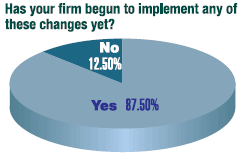
Pricing
Respondents reported that flow generator prices declined by 2 percent in the last 12 months versus the 0.5 percent decline from the fourth quarter 2012 survey. According to prior HME Business Magazine and Mizuho Securities USA surveys, flow generator prices have worsened, but these declines remain in the historical range of 0 percent to -3 percent.
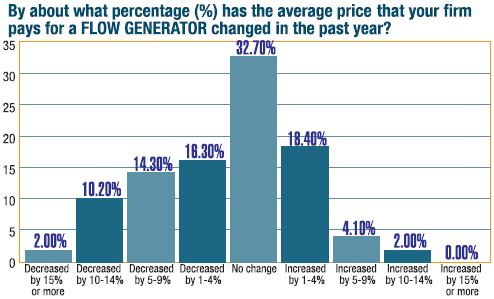
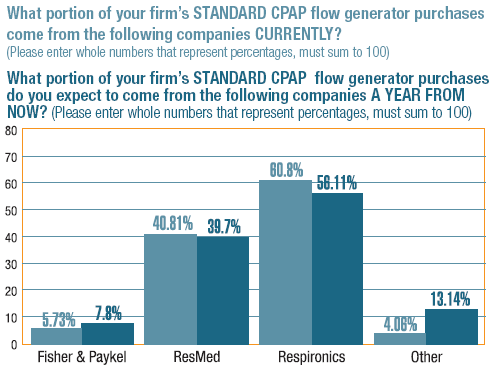
Thirty-three percent of respondents reported no change in price in the last 12 months; 18 percent reported a price increase of 1 percent to 4 percent in the last 12 months: and 16 percent reported a price decrease of 1 percent to 4 percent in the last 12 months.
According to sleep providers responding to the survey, mask prices have declined by 2.2 percent in the last 12 months versus the 1.1 percent decline reported in the fourth quarter survey. According to prior surveys, mask prices have worsened, but these declines remain in the historical range of 1 percent to -2 percent.
Twenty-five percent of respondents said the price decreased by 1 percent to 4 percent in the last 12 months; 23 percent said no change in price in the last 12 months: and 13 percent said the price increased by 1 percent to 4 percent in the last 12 months.
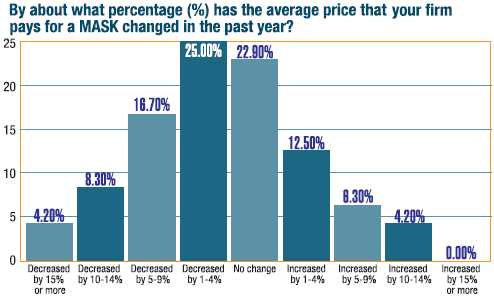
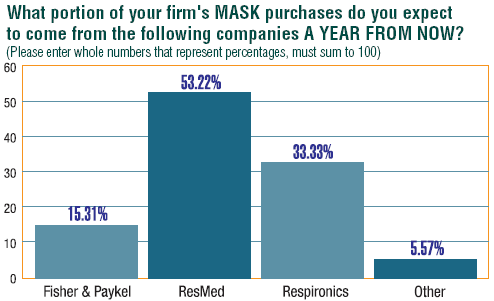
This article originally appeared in the Respiratory & Sleep Management June 2013 issue of HME Business.